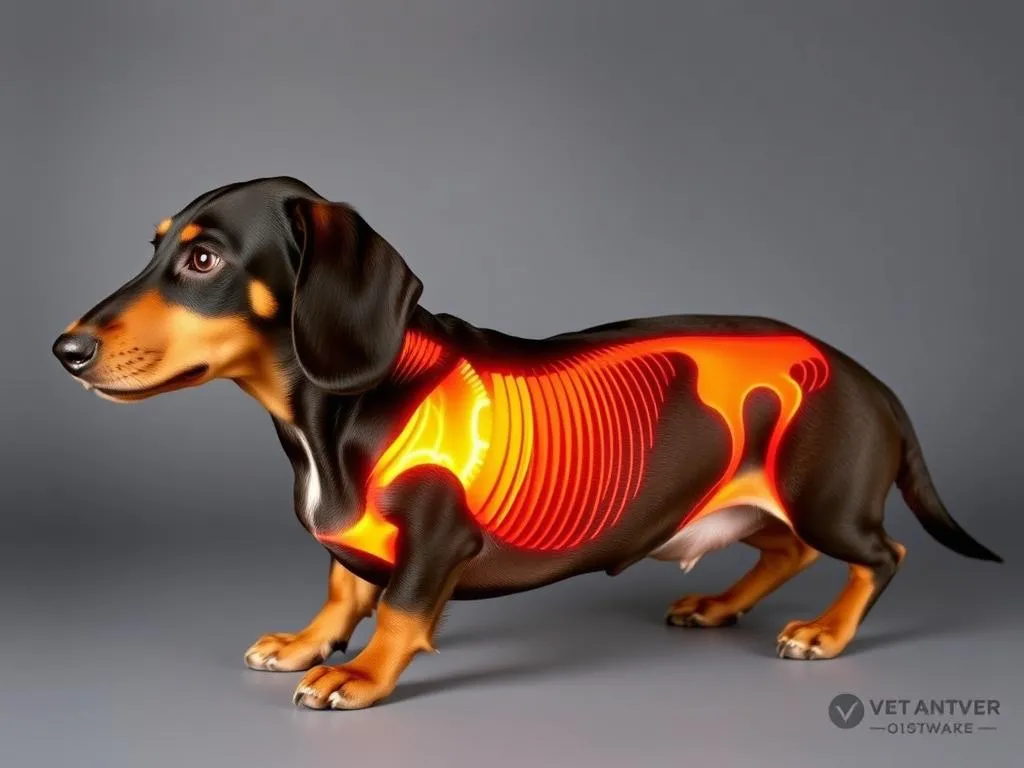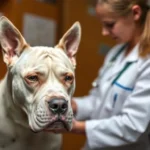
Introduction
Intervertebral Disc Disease (IVDD) is a condition that affects the spinal discs in dogs, leading to pain, mobility issues, and potentially severe neurological problems. Understanding this disease is particularly crucial for dachshund owners, as these charming little dogs are genetically predisposed to IVDD due to their unique body structure. Early diagnosis and treatment can significantly enhance the quality of life for affected dogs, making it essential for pet owners to be informed about this condition.
Dachshunds, with their long backs and short legs, are at a higher risk for developing IVDD compared to many other breeds. This predisposition makes it critical for dachshund owners to recognize the signs of IVDD and seek veterinary advice promptly. This article aims to provide a comprehensive understanding of IVDD in dachshunds, helping owners to better manage their pets’ health.
Understanding Intervertebral Disc Disease (IVDD)
What is IVDD?
Intervertebral Disc Disease refers to a condition where the discs located between the vertebrae of the spine degenerate or herniate. These discs function as shock absorbers for the spine, allowing flexibility and movement. When a disc degenerates, it can bulge or rupture, leading to pressure on the spinal cord and nerves. This pressure can cause pain, weakness, and in some cases, paralysis.
Types of IVDD
Hansen Type I is the most common form of IVDD seen in dachshunds. This type occurs when the disc material calcifies and hardens, leading to a sudden rupture that can compress the spinal cord. Dachshunds typically present with acute, severe signs of pain and neurological deficits.
Hansen Type II, on the other hand, develops more gradually and is often observed in larger breeds. In this type, the disc bulges outwards over time without complete rupture, causing more chronic symptoms. While dachshunds are primarily affected by Hansen Type I, understanding the differences is important for recognizing the severity of the condition.
Causes and Risk Factors
Genetic Predisposition
Dachshunds are genetically predisposed to IVDD due to their elongated spinal structure. The breed’s characteristic long back and short legs contribute to the strain on their spinal discs. This anatomical configuration leads to a higher likelihood of disc degeneration, particularly as they age.
Age and Weight Considerations
As dachshunds grow older, the risk of developing IVDD increases. Aging leads to natural wear and tear of the spinal discs. Additionally, obesity is a significant risk factor, as excess weight increases the strain on the spine and can accelerate disc degeneration. Maintaining a healthy weight through proper diet and exercise is crucial for minimizing this risk.
Activity Level and Lifestyle
The lifestyle of a dachshund can also influence the likelihood of developing IVDD. Dogs that engage in high-impact activities or those that frequently jump or climb may be more susceptible to spinal injuries. Owners should encourage safe play and limit the risk of injury by providing safe environments for their pets.
Symptoms of IVDD in Dachshunds
Common Symptoms
Dachshunds suffering from IVDD may exhibit various symptoms, including:
- Pain and Discomfort: Yelping or whining, especially when picked up or moved, reluctance to walk, and signs of discomfort when touched.
- Neurological Signs: Weakness in the limbs, dragging of the back legs, or even paralysis in severe cases.
Behavioral Changes
Changes in behavior can also indicate IVDD. Affected dachshunds may become less sociable and show changes in appetite. They might avoid play or activities they once enjoyed, signaling discomfort or pain.
Severity of Symptoms
It’s essential to differentiate between mild and severe cases of IVDD. Mild cases might only present with slight discomfort, while severe cases can lead to significant paralysis. Early recognition of these symptoms can lead to timely veterinary intervention.
Diagnosis of IVDD
Veterinary Examination Procedures
When diagnosing IVDD, veterinarians will conduct a thorough physical examination, assessing the dog’s range of motion, reflexes, and any signs of pain. A neurological assessment is also crucial in determining the extent of the disease.
Diagnostic Imaging Techniques
To confirm a diagnosis of IVDD, imaging techniques such as X-rays, MRI, or CT scans are employed. These tools allow veterinarians to visualize the spine and identify any disc herniation or degeneration. Accurate diagnosis is vital for determining the appropriate treatment plan.
Treatment Options
Conservative Management
In many cases, conservative management is the first line of treatment for IVDD. This may include:
- Rest and Medication: Dogs are typically prescribed anti-inflammatory medications and pain relief to manage discomfort. Strict confinement to limit movement is often recommended.
- Physical Therapy and Rehabilitation: Once pain is managed, physical therapy can help strengthen the back muscles and improve mobility.
Surgical Options
If conservative management fails or if the IVDD is severe, surgical intervention may be necessary. Surgical options typically involve decompression of the affected spinal area, which can relieve pressure on the spinal cord. While surgery can be effective, it also carries risks, including complications from anesthesia and the potential for incomplete recovery.
Recovery and Prognosis
Post-treatment Care
Following treatment, whether conservative or surgical, ongoing care is crucial. Regular veterinary check-ups ensure that recovery is progressing well. Owners should also implement home care strategies, such as providing a comfortable resting area and monitoring mobility.
Long-term Outlook
The prognosis for dachshunds with IVDD varies based on the severity of the condition and the treatment chosen. Many dogs recover well with appropriate care, although some may experience recurrence or chronic issues. Preventative measures, such as maintaining a healthy weight and avoiding high-impact activities, can significantly reduce the risk of recurrence.
Prevention Strategies
Lifestyle Adjustments
Pet owners can take proactive steps to help prevent IVDD in their dachshunds:
- Exercise and Weight Management: Regular, controlled exercise helps maintain muscle tone and weight. Avoiding activities that put excessive strain on the spine is also important.
- Proper Handling and Care: Teaching children and visitors how to safely pick up and carry the dog can minimize the risk of injury.
Regular Veterinary Check-ups
Routine veterinary examinations are crucial for early detection of potential issues. Regular check-ups allow veterinarians to monitor the dog’s spine and overall health, providing an opportunity for early intervention if symptoms arise.
Frequently Asked Questions (FAQs)
Common Concerns from Dog Owners
What should I do if my dachshund shows signs of IVDD?
If you notice any symptoms, such as reluctance to move or signs of pain, consult your veterinarian immediately.
Can IVDD be cured?
While IVDD can often be managed effectively, some dogs may experience chronic issues. Early treatment can lead to better outcomes.
Are all dachshunds at risk for IVDD?
Yes, due to their unique body structure, all dachshunds are at a higher risk for developing IVDD compared to other breeds.
Is surgery always necessary for IVDD?
Not always. Many cases can be managed with conservative treatment; however, severe cases may require surgical intervention.
What can I do to help my dog if they are diagnosed with IVDD?
Follow your veterinarian’s recommendations for treatment and rehabilitation, and provide a supportive environment for recovery.
Conclusion
Understanding intervertebral disc disease (IVDD) is vital for dachshund owners. This condition can lead to significant pain and mobility issues but can often be managed effectively with early diagnosis and appropriate treatment. Being vigilant for symptoms, maintaining a healthy lifestyle, and ensuring regular veterinary care can significantly impact your dachshund’s quality of life. By being proactive and informed, you can help your beloved pet lead a happy, active life despite the challenges of IVDD.









